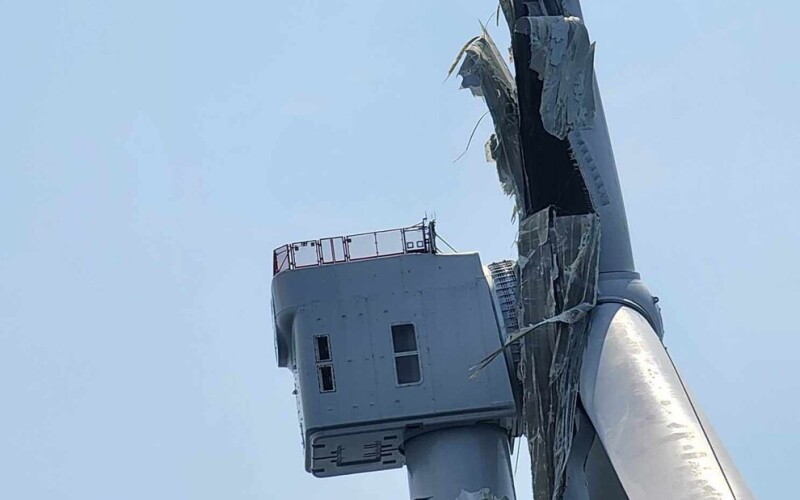The federal Bureau of Safety and Environmental Enforcement extended its order suspending electrical generation and construction at the Vineyard Wind offshore project, as investigations continue into the July 13 turbine blade failure.
BSEE issued a new suspension order July 26 to Vineyard Wind 1 “clarifying operational requirements and listing actions the company must take prior to personnel boarding any wind turbines,” the agency said.
The renewed order came amid enormous pressure on federal agencies and developers over the blade failure that sent fiberglass and plastic foam debris into the sea, washing up on beaches from Nantucket to Cape Cod at the height of the New England tourist season.
In an update at 7 p.m. Monday, Nantucket municipal officials said turbine manufacturer GE Vernova reported that more pieces of the damaged blade on turbine AW38 had detached from the hub of the turbine, with some large pieces entering the water column, and smaller pieces floating on the sea surface and landing on the turbine tower platform.
“According to GE Vernova, this detachment was not unexpected, though it has been several days since any debris detachment was last observed,” Nantucket officials wrote. “GE Vernova and Resolve Marine are working on a plan to safely and controlled remove the remaining portions of the blade. This plan is currently in development.”
Meanwhile the BSEE shutdown order requires that Vineyard Wind, a joint venture of Avangrid and Copenhagen Infrastructure Partners, hold off generation or building or installing new turbine towers, nacelles and blades. The agency required Vineyard Wind to “submit to BSEE an analysis of the risk to personnel and mitigation measures developed prior to personnel boarding any facility.”
However, the developers can carry on other work outside of a safety exclusion zone around the damaged Haliade turbine, such as installing cables and conducting surveys, the agency said.
GE Vernova CEO Scott Strazik said the blade failure was caused by a manufacturing defect at LM Wind Power in Gaspé, Canada, a supplier acquired by GE in 2017. Strazik said 150 blades built at the plant will be reinspected and their testing records reviewed.
That includes blades installed already on other Vineyard Wind turbines. The July 13 failure brought attention to a May 2024 blade failure on a GE Vernova turbine on the Dogger Bank A wind array in the North Sea, that Strazik said involved a mistake during installation.
“As our investigation continues, we are serving as a federal liaison between the responsible party, Vineyard Wind 1, GE Vernova, and other federal, state, local, and Tribal agencies,” said BSEE Director Kevin Sligh. “We are continuously engaged across all the incident response entities to ensure response operations are well coordinated and conducted safely through information sharing, planning and analysis of proposed activities.”
“BSEE prioritizes offshore worker safety and environmental protection, and we will use all tools available to ensure compliance with safety and environmental regulations on the Outer Continental Shelf,” said Sligh.
The agency had just conducted its first inspection of an operational turbine in U.S. federal waters June 12 at the South Fork Wind project of 14 machines off New York and Rhode Island.
Barely a month later, BSEE and the Bureau of Offshore Energy Management are dealing with a potential crisis for the Biden administration’s offshore wind efforts. Opponents of East Coast offshore wind projects, like elected officials in Cape May, N.J., are pressing their new advantage in the public debate, .
“We were right to oppose offshore wind,” said Leonard C. Desiderio, director
“This was one section of one turbine blade. Had Ørsted succeeded in constructing Ocean Wind One and Two and Skipjack, we would have had nearly 1,000 such blades spinning just miles off our beaches.”





